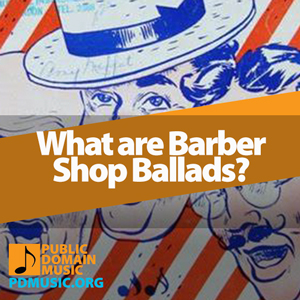 What Are Barber Shop Ballads?
What Are Barber Shop Ballads?
Contents [show]
Barbershop ballads are a distinctive style of music traditionally performed by a cappella quartets. This style, deeply rooted in American musical tradition, is known for its rich harmonies, sentimental melodies, and emotive delivery.
It emerged in the late 19th and early 20th centuries and remains popular in contemporary times, celebrated for its unique blend of harmony and nostalgia.
Origins and History of Barbershop Ballads
Barbershop ballads trace their origins to the African American communities in the southern United States. They were popularized in barbershops, where men gathered and spontaneously harmonized, singing folk songs, spirituals, and popular tunes of the day.
This informal tradition of communal singing evolved into a more formal genre, characterized by its distinct harmonious structure.
Characteristics of Barbershop Ballads
A typical barbershop ballad features four vocal parts: the lead, singing the melody; the tenor, harmonizing above the melody; the bass, providing the lowest harmonizing notes; and the baritone, completing the chord.
These songs are known for their close, consonant four-part harmonies, “ringing” chords, and a cappella style. The melodies are often simple and nostalgic, with lyrics that evoke sentimental themes.
Evolution and Popularity
While the golden age of barbershop music was in the early 20th century, it saw a revival in the mid-20th century with the formation of organizations like the Barbershop Harmony Society.
This revival spurred the growth of quartet competitions, performances, and a dedicated community of barbershop enthusiasts. Barbershop ballads have since become a beloved part of American folk music.
Barbershop Ballads in Cultural Context
Barbershop ballads are more than just a musical style; they represent a slice of American cultural history. They reflect the social and musical dynamics of their time, showcasing the blend of various musical influences and the communal spirit of American life in the early 20th century.
Notable Barbershop Songs and Groups
Some of the most beloved barbershop songs include classics like “Sweet Adeline,” “My Wild Irish Rose,” and “Let Me Call You Sweetheart.” Famous barbershop groups like The Buffalo Bills, The Mills Brothers, and The Gas House Gang have contributed significantly to popularizing and preserving this musical tradition.
Most Popular Barber Shop Ballads
This page lists some of the most popular Barber Shop Ballads along with other songs and music in the barber shop style. These songs weren’t originally written by Sigmund Spaeth, but his arrangements are detailed in his book: Barber Shop Ballads And How To Sing Them.
Each of these ballads were entered into the public domain in 1987 and are listed below in the same order as they appear in Spaeth’s book. Check them out. Many of these are fun pieces written for male quartets. This is truly the beginning of the modern day A cappella groups like “Straight No Chaser” and Pentatonix.
Music in the Barber Shop Style
Barbershop Music in Modern Times
Today, barbershop music continues to thrive, with numerous barbershop societies and quartets around the world. It is celebrated in various festivals, competitions, and performances, drawing participants and audiences who cherish the art of close harmony singing.
Barbershop Music and Education
Barbershop music is also recognized for its educational value. Many music educators use barbershop arrangements to teach harmony, ear training, and ensemble singing.
Its accessibility and the requirement for precise pitch and harmony make it an excellent tool for developing musical skills.
Conclusion
Barbershop ballads hold a special place in the realm of vocal music, celebrated for their harmonious beauty and nostalgic charm. As a unique expression of American musical heritage, they continue to resonate with audiences, preserving a tradition of harmony and community singing.
Whether performed in competitions, concerts, or casual gatherings, barbershop ballads remain a vibrant and beloved part of the musical landscape.
Frequently Asked Questions
What defines a barbershop ballad?
A barbershop ballad is defined by its four-part a cappella harmony, consisting of lead, tenor, baritone, and bass parts, with a focus on sentimental, melodic songs.
What is the origin of barbershop ballads?
Barbershop ballads originated in African American communities in the southern United States and were popularized in barbershops as a form of communal singing.
What are the key characteristics of barbershop music?
The key characteristics include close, consonant four-part harmonies, the use of ‘ringing’ chords, and a distinctive a cappella style.
How do barbershop ballads differ from other types of music?
Barbershop ballads differ in their specific harmonic structure, a cappella performance, and the emphasis on nostalgic and emotional themes.
What are some classic barbershop ballads?
Classic barbershop ballads include “Sweet Adeline,” “My Wild Irish Rose,” and “Let Me Call You Sweetheart.”
Who are some notable barbershop quartets?
Notable barbershop quartets include The Buffalo Bills, The Mills Brothers, and The Gas House Gang.
How has barbershop music evolved over time?
Barbershop music has evolved through various revivals, adapting to modern influences while maintaining its traditional harmony and style.
What is the significance of barbershop music in American culture?
Barbershop music holds cultural significance as a representation of American musical heritage and communal singing traditions.
What role does barbershop music play in modern music education?
In modern music education, barbershop music is used to teach harmony, ear training, and ensemble singing skills.
Are barbershop ballads still popular today?
Yes, barbershop ballads remain popular, with active communities, competitions, and performances celebrating this unique musical style.
